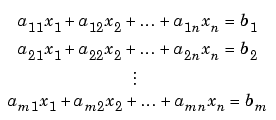

| Financial Toolbox |   |
Solving Simultaneous Linear Equations
Matrix division is especially useful in solving simultaneous linear equations. Consider this problem: given two portfolios of mortgage-based instruments, each with certain yields depending on the prime rate, how do you weight the portfolios to achieve certain annual cash flows? The answer involves solving two linear equations.
A linear equation is any equation of the form

where a1, a2, and b are constants (with a1 and a2 not both zero), and x and y are variables. (It's a linear equation because it describes a line in the xy-plane. For example the equation 2x + y = 8 describes a line such that if x = 2 then y = 4.)
A system of linear equations is a set of linear equations that we usually want to solve at the same time; i.e., simultaneously. A basic principle for exact answers in solving simultaneous linear equations requires that there be as many equations as there are unknowns. To get exact answers for x and y there must be two equations. For example, to solve for x and y in the system of linear equations

there must be two equations, which there are. Matrix algebra represents this system as an equation involving three matrices: A for the left-side constants, X for the variables, and B for the right-side constants

Solving the system simultaneously simply means solving for X. Using MATLAB,
So x = 3 and y = 7 in this example. In general, you can use matrix algebra to solve any system of linear equations such as

by representing them as matrices

To illustrate, consider this situation. There are two portfolios of mortgage-based instruments, M1 and M2. They have current annual cash payments of $100 and $70 per unit, respectively, based on today's prime rate. If the prime rate moves down one percentage point, their payments would be $80 and $40. An investor holds 10 units of M1 and 20 units of M2. The investor's receipts equal cash payments times units, or R = C * U, for each prime-rate scenario. As word equations,
| M1 |
M2 |
|
| Prime flat: |
$100 * 10 units |
+ $70 * 20 units = $2400 receipts |
| Prime down: |
$80 * 10 units |
+ $40 * 20 units = $1600 receipts |
Now the investor asks the question: given these two portfolios and their characteristics, how many units of each should I hold to receive $7000 if the prime rate stays flat and $5000 if the prime drops one percentage point? Find the answer by solving two linear equations.
| M1 |
M2 |
|
| Prime flat: |
$100 * x units |
+ $70 * y units = $7000 receipts |
| Prime down: |
$80 * x units |
+ $40 * y units = $5000 receipts |
In other words, solve for U (units) in the equation R (receipts) = C (cash) * U (units). Using MATLAB left division
The investor should hold 43.75 units of portfolio M1 and 37.5 units of portfolio M2 to achieve the annual receipts desired.
 | Dividing Matrices | Operating Element-by-Element |  |